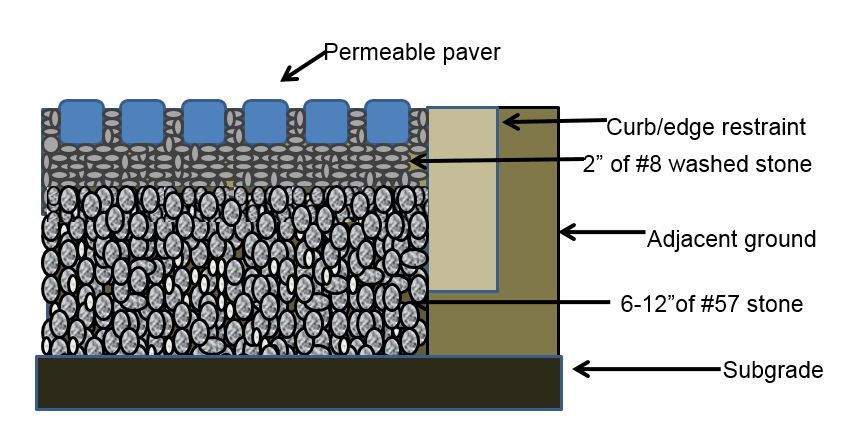Permeable Pavers and Surfaces
Is Your Project Subject to Stormwater Regulations?
The information provided on this page is intended for pervious surfaces that are installed on a voluntary basis. If your project requires a Land Disturbing Activity (LDA) Permit and is subject to stormwater regulations, the installation must follow the specifications found in the Virginia Department of Conservation and Recreation Design Specification No. 7 for Permeable Pavement and the Arlington Stormwater Manual. You must follow your approved plan during installation.
Benefits of Pervious Surface
- Get a credit on your stormwater utility fee if you have a permeable driveway or parking area!
- An aesthetically pleasing surface that could increase your property value.
- A life span equal to or greater than standard asphalt. It may not need to be replaced for 30 years or more (as compared with 20 years for standard asphalt).
- Paver stones can be replaced in sections on an as-needed basis, extending the life span of the overall surface.
- A reduction in stormwater runoff from your property. This also reduces the amount of sediment and other pollutants that would be washed away with the runoff.
- Groundwater recharge. The slow release of water allows it to soak into the ground, which supplies water to local streams in between storms.

The pavers’ ridges ensure that they are installed with the proper spacing, which allows water to drain between the pavers.
For pervious driveways to function properly, it’s very important to use the proper rock in the sublayers. Use the specifications in the resources section to the right as a guide when working with your contractor.
Do I need a permit to install a new driveway?
- As long as the driveway replacement will not involve a construction area greater than 2,500 square feet, and the project is not part of a larger construction project, you shouldn’t need a permit.
- If you’re planning to disturb the sidewalk or driveway apron, you’ll be required to pay for the replacement apron.
- If you’re planning to expand the size of the driveway, you’re required to confirm that you’re within the zoning lot coverage requirements.
Interlocking Paver Specifications
- A curb or edge is needed to ensure that pavers stay in place. If pavers are adjacent to curbs or foundations, an edge on that side may not be necessary.
- #2, #8 and #57 are permitted stone types for permeable driveways.
- Use 2 inches of #8 stone as a bedding layer.
- Use 6-12 inches of #57 stone as the reservoir layer. The depth is dependent on the infiltration test results.
- The #2 layer is used in special circumstances below the #57 layer.
- Sand is not used in any of the layers.
Does it matter which geotextile fabric is used with a pervious installation?
What are the special considerations for sloped driveways?
- Permeable pavements may not be installed in areas adjacent to 20% or greater slopes.
- The slope of the final, installed driveway must be 10% or less.
- The driveway’s subgrade must have a 0% slope.
- Sites with slopes greater than 5% require flow barriers or check dams. See the Arlington Stormwater Manual for further information.

Cross-section of a typical residential pervious driveway or patio with close to 0% slope.
Maintenance
Maintenance of permeable pavement is driven by annual inspections that evaluate the condition and performance of the pavement. It’s very important to avoid clogging the openings in your pervious surface. These openings allow water to infiltrate and soak into the ground. Don’t use sand or other materials that may clog openings on the pervious surface, and periodically sweep off leaves and other organic debris. Follow any additional manufacturer recommendations for the type of pervious surface installed. The following are annual maintenance inspection points for permeable pavements:
- If an observation well is present, measure the drawdown rate at the observation well for three days following a storm event in excess of one-half inch in depth. If standing water is still observed in the well after three days, this is a clear sign that clogging of the pavement is occurring.
- Inspect the surface of the permeable pavement for evidence of sediment deposition, organic debris, staining or ponding that may indicate surface clogging. If any signs of clogging are noted, schedule a vacuum sweeper (no brooms or water spray) to remove deposited material. Then, test sections by pouring water from a 5-gallon bucket to make sure they work.
- Inspect the structural integrity of the pavement surface, looking for signs of surface deterioration, such as slumping, cracking, spalling or broken pavers. Replace or repair affected areas, as necessary.
- If applicable, check inlets, pre-treatment cells and any flow diversion structures for sediment buildup and structural damage. Note if any sediment needs to be removed.
- Inspect the condition of the observation well, if present, and make sure it is still capped.
- Generally inspect any contributing drainage area for controllable sources of sediment or erosion.